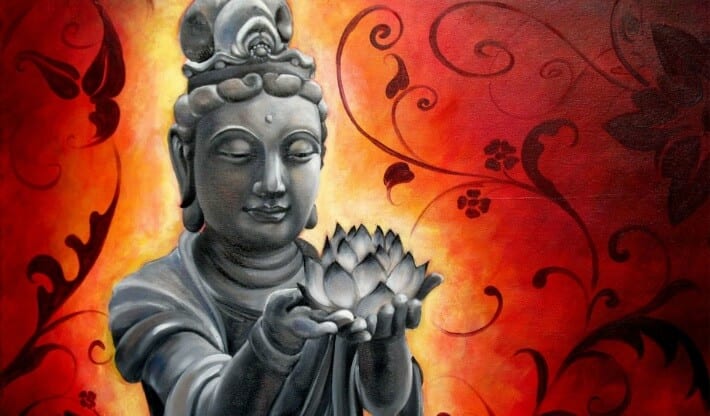NAB: What is the relationship between the sacred feminine, Buddhism and an environment in a state of crisis? In any sense, was the Buddha a feminist, or how did he access and balance femininity and masculinity on his path to enlightenment?
Thanissara: Buddhism recognizes the inter-dependence of all things. This means we exist in a web of life in which we are all connected. For example, our collective survival depends on humans evolving out of an egoist consciousness that falsely believes it exists in an independent state. The individuated self has its own necessary function, but when the truth of interdependence is consistently denied, we become imprisoned. It might be a very attractive prison, but the depths of the mind’s energy will invert and be trapped into reactive patterns of fear and desire. The lack we feel, that burns so deep, continually generates an insatiable restlessness that fuels our poignant, destructive, and ultimately futile attempts to control, own, and dominate the world around.
The Sacred Feminine: Not Defined by Gender
On the other hand, a direct knowing of our inter-connection initiates us into the sacred feminine. While women likely have an easier access into this truth, the sacred feminine is not defined by gender. Essentially, it is a deeply receptive way of being in relationship with a living world, where everything is consecrated by an indwelling consciousness. Even the molecules in the air are pregnant with life giving energy. Trees, plants, rocks, animals, and the beings around us are all part of one living gestalt. When we tune into that, then the Eros energy of undifferentiated love suffuses our being.
Unfortunately, our current worldview has de-souled the living world, rendering it inanimate, dead, and devoid any sacredness. Patriarchy, and patriarchal religions, of which Buddhism is one, fears the energy of Eros due to its connection with sexual power, birth, and the instinctual realm of primal feeling. Patriarchy goes to great lengths to repress and demonize the living influence of the sacred feminine, and therefore women, only to replace it with the distortions and opressions of power.
…sensitivity to the energetic experience of embodiment reveals how deeply interconnected we are with the environment, people, and the world.
The reclamation of the feminine is supported by body-based awareness practices. Meditation that opens into the felt experience of body is a good starting place, and is primary to the Buddha’s teaching. It reconnects us to the energetics of being within a relational field. Our thoughts make us feel independent and separate, but sensitivity to the energetic experience of embodiment reveals how deeply interconnected we are with the environment, people, and the world. The body also carries ancestral, familial, personal and karmic history, all of which can be accessed through awareness based practices. Bringing attention to the body, its feelings and sensations, is not easy, at least until we develop some meditative capacity, but it is important. Increased body awareness opens beyond the cognitive into a different way of knowing, one that is born of contemplation. This knowing is intuitive, and while not dependent on the cognitive, when actualized through the cognitive, it distills into authentic wisdom.
When meditation and Dharma practice is overly focused on a hierarchy of attainment, and the development of techniques, it tends to be subsumed into a patriarchal agenda of power, and control. Then rather than understanding our inner processes, we are disassociated from them. Our collective wound of soullessness, emerging from centuries of being ripped from the web of belonging, undermines our ability to trust the Dharma. Instead, we sometimes try and fill our inner lack by using the Dharma for accumulating prestige, wealth and acknowledgment. When this happens the liberating potential of Dharma practice is distorted and diluted. Instead we become conditioned as “good meditators” or “nice, spiritual people” and perhaps unwittingly acquiescent in another competitive, money based, industry, which leaves us forever chasing the elusive goal of “peace” and “enlightenment.” These pitfalls, alongside introversion, and ambivalence about engaging the world, or settling for being a bit more functional in dysfunctional systems, undermine the ability of Buddhism to vitalize its radical edge in service of the environment.
Enlightenment: Through the Door of the Sacred Feminine
What is important to understand is that the Buddha was radical; he engaged his culture, challenged it, and changed it; his example can inspire the kind of activism we now need to secure a livable planet. It is also my understanding that it was not possible for the Buddha, (or anyone else), to open into “enlightenment” without going through the door of the sacred feminine. This happened for the Buddha when he realized the utter uselessness of his attempts to control his experience through the life-denying spiritual practices of his day. On the verge of death, due to his self-inflicted asceticism, he finally accepted an offering of milk rice from the maiden Sujata. At that moment, he opened to the energy of Eros, or the archetypal feminine. This, and a childhood memory that led him to be with his breath, became the ground of his awakening. An awakening that was confirmed by Mother Earth, who had borne witness to the struggles he undertook through numerous cycles of rebirth.
Once the initiation of the sacred feminine is undertaken, then, as for the Buddha, the balance of masculine and feminine energy is actualized through service to the Dharma. The masculine defines, clarifies and directs, while the feminine attunes, resonates and responds. A Buddha is one who perfectly balances both energies. This ideal is depicted in Buddha statues, which tend to be androgynous. The Buddha’s own service led him to open the doors of his new religion to women. Women loved the Buddha because he offered them self-determination. He accepted and supported them. The erroneous misogynist distortions scripted into Buddhist transmission over centuries, are not the work of the Buddha. He did not fear women; he freed them. In the same way, honoring the sacred feminine, and restoring its rightful place will not only invigorate Buddhism, but it will help bring our world back from the brink of destruction.
Meditation: Unlocking Mind-Heart Energy (Citta)
NAB: In what ways can someone tap into the sacred feminine in regular meditations?
Thanissara: A way into the sacred feminine is to shift away from the “subject– object” nexus, which is fueled by conceptual abstraction, generating a dissociating layer over our direct energetic experience. We assume we know others, this world, and ourselves through our perceptions, memories and thoughts, however; this way of knowing is partial, and usually misleading. Caught in that dynamic, the mind perpetually ricochets in reaction to the distancing effect of interpreting life through the cognitive realm. This in turn keeps the mind-heart (citta) energy locked into patterns of longing, anxiety and agitation.
Instead, contemplate the energetic experience of being in a relational field. In Buddhist practice, this is called yoniso manisikara, which roughly means “put the body-mind creations into the womb of awareness.” Do this by dropping beneath thinking, into body sense. Soften, and open into feeling and sensation. This is not easy without getting tangled in feelings, so it’s important to remember to be kindly present “with” feeling tones, rather than caught up “in” them.
The sacred feminine is profound nourishment.
Breathe into, and through, what is felt. Suffuse the subtle energy of the in and out breath through the body. Stay with the body and the rhythm of the breath, allowing the energetic experience of the body to be fully received into awareness. You can do this throughout waking hours, sitting at the computer, at the grocery line, no need to wait for special meditations. To help negotiate the power of feeling, stay connected with the earth element as felt in the body – bones, spinal column, pressure of feet on the ground, and sitting in a chair, for example.
The practice deepens as we allow, and accept, our experience, listening into its energetic variances. We can enhance this deepening quiet during meditation sessions, (and other times of course), by asking, “What’s happening now?” Listen into “what is” until you hear what is present. Aim to go beneath the storylines into what is felt. Then listen again. Listen until you hear a deeper awareness listening with you. This could be called “listening into the heart-mind ground.” This listening begins to turn the mind back into itself, into its own awareness. This is the subtle meditation of Kuan Yin, the Buddhist archetype of merciful compassion. The practice of listening into the heart of awareness opens into the sacred feminine. Here, our listening is the same listening within all beings. This is listening into the web of life, which is an intelligence that speaks to us as intuitive guidance.
Another way into the sacred feminine is to be in nature. Even if in a city, notice trees, birds, clouds, and the presence of others. Notice their face, smiles, and struggles, notice small things, and allow all of it as part your world, without creating a “me” it’s happening to. Do this by softening your gaze, and opening your awareness until you feel everything arrive intimately into the presence of the heart.
The sacred feminine is profound nourishment. Explore what brings you lightness, ease, beauty, and joy. Perhaps walking, qi gong, swimming, dancing, writing poetry, and being with friends. Notice, when partaking of enjoyment, the feeling of Eros energy in the body, felt as fullness, and emerging as the creative impulse. You see that energy in children, and you may recognize it in yourself as effortless being. Or lie on the grass, in a park, your yard, or in a forest, or sit under a tree and talk to it! Feel the earth beneath you, breathe in her fecundity, and express your gratitude to her.
One great Thai meditation master said, “Never abandon the body.” We live in a time when a billion dollar advertising industry gives the message that women’s bodies are unacceptable unless semi anorexic, photo-shopped, mostly white, and youthful. These messages act on a subliminal level, undermining our capacity to be embodied, and accept our bodies as they are. Women are also shamed for ageing, for not being “pretty” any more. However, eldership is a time of power for women. The process of menopause strips away pretentions, and the need to put oneself into a pretzel shape in order to please. Women can be fierce elders, willing to speak truth plainly, not out of anger or spite, but for the sake of truth itself. It’s important therefore, that we counter these erroneous myths about how women should look and be, by being kind and accepting of our bodies.
This also applies to men, as now the same impossible standards of an unattainable physique, and unending sexual prowess are projected onto their bodies; all of which generates billions for pharmaceuticals. To resist these messages, instead loving our bodies from the inside, rather than for what they look like on the outside, is in itself a radical act.
NAB: What can women, and those attuned to feminine energy, qualities and values bring to a world in crisis?
Thanissara: The feminine is primarily relational. It feels with others, and also tends to be receptive to subtler levels of energetic information, nuance, and complexity. Relationship implies responsibility, the ability to respond authentically. What the world really needs, at this time, is merciful healing and empathetic alliance, not more brute, exploitive use of power activated by a separative consciousness that seeks to dominate and extract from nature.

© Jayna Simpson
Sometimes compassion is considered weak, but to withstand hatred, and turn it around into clarity and careful consideration, takes far more strength than the use of violence. We can see that in the examples of Aung San Suu Kyi and Mr. Mandela. We can use examples of those who challenged power without defaulting to hatred, to help us see how it is done. What is important in these times is to realize we can’t act alone. We need to collaborate so that together we can generate, as Gandhi called it, Satyagraha, a “Truth Force” that can challenge the corporate oligarchy, which is condemning us all to live in an unviable world.
Entering into a Respectful Relationship with the Earth
NAB: What are some consequences of failing to recognize and incorporate the sacred feminine in one’s own life and what impact might this have on others?
Thanissara: Well, unfortunately, society tends to remunerate the narcissistic, sociopathic behavior we see in the uber-billionaire class, in corporate excesses, Wall Street, the NRA, and the military-industrial complex. Historically patriarchal power is rewarded, and what is ignored are the voices of parents, for example, losing their children in another mass college shooting, or in wars, or as a result of political demagoguery that crushes careful, diplomatic processes, for example, in Iraq, where children now suffer from extreme birth defects due to the “dirty bombs” loaded with depleted uranium that were dropped by the USA.
In the face of an out of control capitalist empire, that pays corporate CEOs thousands of dollars an hour, and school teachers, maybe $15 to $20 an hour, it is hard to have courage and confidence in the power of the sacred feminine. But, at this critical juncture, we face a clear choice; either we learn to enter a respectful relationship with the earth, to live sustainably, and to negotiate careful international relationships, or we must prepare for the appalling impact of a warming biosphere, increased desertification, extreme weather events, resource wars, continued mass migrations, and the likely collapse of human civilization.
NAB: To you, what is the source of the sacred feminine? Is its domain the heart, the mind, the earth, a combination of these, or elsewhere?
Thanissara: That’s a good question. I suppose I would say primarily it is the Earth, which is the great mother. She nourishes us all. For First Nation People, and those living within a shamanic perspective where consciousness is understood as immanent within all life forms, the Earth is sentient, deeply intelligent, and conscious. Back in the mists of time, this immanence within the natural and human world was equated with the Goddess energy of pre-patriarchal religion. Before patriarchal religion placed itself as a conduit for the sacred, shamans engaged directly with cosmic and immanent consciousness, often through the use of sacred psychotropic plants, trance, or meditative methods. Fortunately, shamanic knowledge and rites could not be completely repressed. In fact, nowadays, there is a revival of interest in these methods, which is helping reclaim the sacred.
Consciousness itself has evolved from the instinctual to being self-aware, particularly within humans. This same consciousness is mapped in Buddhist, and other, contemplative traditions. Outside much of Western Buddhism, many Buddhist schools attribute consciousness to the earth and elemental spirits, as well as to a vast range of subtle realms. In the Shurangama Sutra, a Mahayana text, the primal root of the mind is named as “pure consciousness.”
To say pure consciousness is the “sacred feminine” is not correct, as pure consciousness cannot be located within any attribute. However its essence is buddhi, which means, “pure knowing.” This “knowing” is equated in Buddhist, and other contemplative traditions, with the feminine. Buddhism has the female figure of prajna-paramita, who represents the deepest wisdom that emerges from intuitive knowing. It is this space of intuitive insight that gives birth to the wisdom of the Buddhas. Ultimately, we have to acknowledge that consciousness is a mystery. We could therefore say that the sacred feminine, while profoundly ancient, instinctual, embodied, self aware, and immanent, is also profoundly mysterious.
Part II of this interview touches on mobilizing feminine energy for transformation, the wounded masculine, and the role of the sacred feminine in addressing our environmental crisis.









One Response
There is certainly a strong component of the feminine that is present when awakening, however, I think it should be balanced with masculine energy. This article seems to praise feminine energy over masculine energy (and in some instances, the masculine seems demonized in this article) when in reality both are needed. There are tons of comments about the “patriarchy” on here. There’s no one oppressing women, it’s more coming from feminist views – which aren’t relevant to Buddhism or spirituality (which sees no distinctions). As you say in your article “A Buddha is one who perfectly balances both energies.”! Masculinity provides wisdom, clarity, and healthy power to cut through impediments and obstacles that the feminine is unable to do on her own.